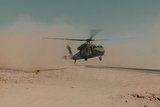Air Force weapons program expands UAS lethality
US Air Force representatives are currently reviewing industry white papers describing new weapon designs and technologies that could expand the lethal aspects of future UAS operations.
The industry white papers were solicited by the Munitions Directorate of Air Force Research Laboratory (Eglin AFB, Florida), under a Broad Agency Announcement titled “Miniature Weapon Demonstration” (MWD).
As described in the initial announcement, “MWD serves as a risk reduction program for development of airframe, miniature ordnance package and guidance, navigation and control (GNC)/seeker technologies needed for an air-launched, precision miniature munition capability. Such a precision miniature munition would provide a mobile target kill capability against a broad set of targets in a suburban environment. The challenge is to design a robust suite of technologies that will integrate into an affordable solution.”
Program objectives include the identification, assessment, development, and demonstration of “an affordable precision miniature weapon concept. The primary technology area to be developed and demonstrated should include miniature ordnance package (warhead, fuze and safe & arm), miniature weapon guidance/seeker technologies and agile airframe technologies.”
Although the Broad Agency Announcement does not specifically identify unmanned aerial systems as MWD platforms, industry participants widely believe that the requirement is optimized for UAS application.
Industry white paper responses were submitted on 1 June 2009, with the stated government expectation “that one of the white papers may be selected for further consideration, and its originators may subsequently be requested to submit formal written technical and cost proposals, with the intent of negotiating one contract for the MWD program. However, the Government reserves the right to award one, multiple, or no contracts pursuant to this [Broad Agency Announcement].”
It is expected that any follow-on contracts will consist of two task orders: Concept Development and Preliminary Testing (ranging from Technology Readiness Level assessment to risk reduction compoent level testing); and Concept Refinement, Component Testing & Initial Flight Test Vehicle Design.
According to the initial announcement, the Government anticipates negotiating one Indefinite Delivery, Indefinite Quantity (IDIQ), Cost-Plus-Fixed-Fee (CPFF) contract for the MWD effort, with the first task order issued with contract award and the second task order awarded only after review of initial task order deliverables.
Although the Government expects to fund up to approximately $7 million on contract for those task orders the potential expansion to a $17 million ceiling on the IDIQ could allow for additional in-scope tasks to be awarded later if additional funding becomes available.
Based on the white papers already submitted, the government expects to request proposals within 2 weeks, to receive proposals within 30 days thereafter, and to negotiate and award one or more contracts within 8-9 weeks after that (Sep 2009).
More from Uncrewed Vehicles
-
![What's next for the Pentagon after the Replicator programme?]()
What's next for the Pentagon after the Replicator programme?
Although the Replicator initiative has made several accomplishments, there are still multiple gaps to plug across the US Department of Defense (DoD) and its services.
-
![Cummings Aerospace showcases Hellhound loitering munition designed for US Army’s LASSO programme (video)]()
Cummings Aerospace showcases Hellhound loitering munition designed for US Army’s LASSO programme (video)
Cummings Aerospace presented its turbojet-powered Hellhound loitering munition at SOF Week 2025, offering a man-portable solution aligned with the US Army’s LASSO requirements.
-
![SOF Week 2025: PDW unveils attritable FPV drone for SOF operations at scale]()
SOF Week 2025: PDW unveils attritable FPV drone for SOF operations at scale
PDW has revealed its Attritable Multirotor First Person View drone at SOF Week 2025, offering special operations forces a low-cost, rapidly deployable platform for strike and ISR missions, inspired by battlefield lessons from Ukraine.
-
![SOF Week 2025: Teledyne FLIR white paper provides guidance on reusable loitering munitions]()
SOF Week 2025: Teledyne FLIR white paper provides guidance on reusable loitering munitions
Teledyne FLIR is highlighting the emerging requirements for 'recoverable and re-usable' loitering munitions across the contemporary operating environment during this week’s SOF Week conference in Tampa, Florida.
-
![SOF Week 2025: Kraken Technology group debuts K3 Scout USV in North America]()
SOF Week 2025: Kraken Technology group debuts K3 Scout USV in North America
High-performance maritime industry player Kraken Technology Group, based in the UK, has used the SOF Week conference in Tampa, Florida this week to debut its K3 Scout uncrewed surface vessel (USV) to the North American market.
-
![Palladyne AI and Red Cat to demonstrate capabilities for autonomous drone swarms to the US military]()
Palladyne AI and Red Cat to demonstrate capabilities for autonomous drone swarms to the US military
Red Cat and Palladyne AI recently conducted a cross-platform collaborative flight involving three diverse heterogeneous drones.


























